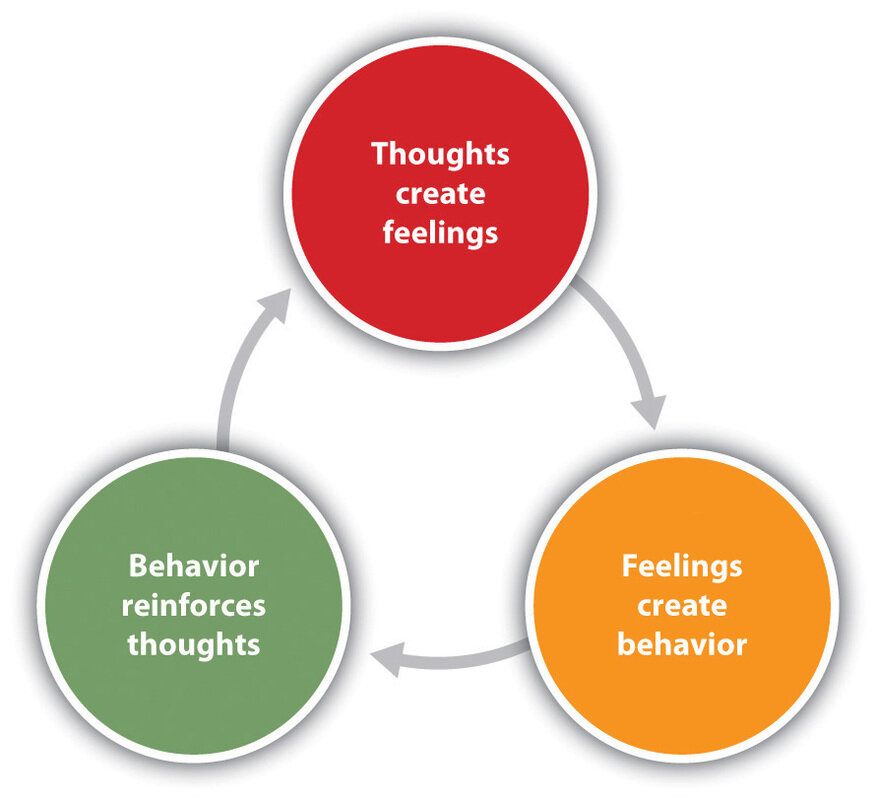7 Emotions Include Your Thoughts and Feelings: “They are Yours to Own”
When trying to understand the complexities of our emotions more clearly, we can consider the components that make up emotional experience: Thoughts, Feelings and Behaviours. The consideration of these three components together is what makes up the three component model of emotions. This model is used in Cognitive Behavioural Therapy to help us to understand the components of our emotional experiences, how they interact with one another and how by changing one component, we can change other components as well.
An In Depth Look at The Three-Component Model of Emotions
According to Cognitive Behavioural Therapy (CBT), there are three components that make up our emotional experience: Thoughts, Feelings and Behaviours
Thoughts: “Thoughts refer to the ways that we make sense of situations. Thoughts can take a number of forms, including verbal forms such as words, sentences, and explicit ideas, as well as non-verbal forms such as mental images. Thoughts are the running commentary we hear in our minds throughout our lives” (Bonfil & Wagage, 2020).
Feelings: The term feelings doesn’t refer to emotion, but rather, the physiological changes that occur as a result of emotion. For instance, when we feel the emotion of anger, we have the feeling of our face flushing. When we feel the emotion of anxiety, we have the feelings of our heart pounding and muscles tensing. Feelings are the hard-wired physiological symptoms of emotion.
Behaviours: Behaviours are the things we do. Importantly, behaviours are also the things we don’t do. For instance, we might bow out of public speaking if we feel overwhelming anxiety. On the other hand, if we feel confident, we might seek out those engagements (Cognitive Behavioral Therapy, 2020).
Cognitive Behavioural Therapy encourages us to consider that: “each of these components interacts with the other to create moods and emotional patterns and changing one component results in a chain reaction that changes the others” (CBT, 2020).
For additional information visit: https://cogbtherapy.com/cbt-model-of-emotions
Thoughts, Feelings and Behaviours: They are yours to own!
This section begins with discussions and activities that support understanding our emotions and how we process them. Emotions are complex and individual. Coming to understand our emotions when we are struggling with an eating disorder may help us appreciate how these emotions affect our decisions and therefore our behaviours during this time. Paying attention to emotions and how you process them is part of healing from an eating disorder (Fox, 2009). Oftentimes, life can be very chaotic and the chaos can cause us to lose the connections we have with our emotions. Yet, emotions are part of our holistic wellbeing and we must learn to understand our emotional make-up.
When you begin to receive care, it can be challenging for a person to understand why therapists and eating disorder team members focus on our emotions and how we manage our emotional responses. As well they will focus on how these emotions and emotional management strategies are affecting your physical health (Remember how thoughts, feelings and behaviours are all intertwined?).
The National Eating Disorder Association (2022) identifies over 20 emotional and behavioral signs of an eating disorder https://www.nationaleatingdisorders.org/
This is important as at times, we may not always be connected to our emotions and may not see the warning signs.
Creation Space
- When you go to the NEDA site do you see yourself reflected in the signs?
- What signs do you identify with?
Screening for Risk
The National Eating Disorder Association (2022) offers a screening tool to assess whether an individual may struggle from an eating disorder. This screen is for people aged 13 and older. Each question must be answered before the screening tool allows you to move to the next set of questions. The screening tool takes about ten minutes to complete. You can have the results from your screening emailed to yourself and then you get a follow-up survey in two months.
Creative Space
- Please try this screening tool!
- Have you learned anything new?
The Language of Emotions
In this section, we start with a discussion from Hannah about the complexities of her emotions:
Hannah: “Emotions are complex, I bury the pain and the anxiety when I can. I avoid feeling the discomfort that comes with trauma. If I can change my thoughts and focus on something other than pain then I will be okay. I just do not want to feel sad today.”
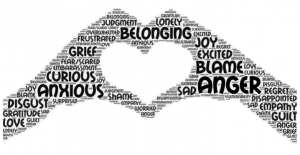
Creation Space:
The above is an example of a word cloud. You can make a word cloud reflecting your life. For example: https://www.freewordcloudgenerator.com/generatewordcloud
Janet also discusses her greatest challenges during treatment for her eating disorder:
One of my greatest challenges in the early days of treatment was understanding the words and essentially language was attached to my emotions. In time, I learned being silent was not a good way to communicate my feelings or perspectives. I was just quiet. Too quiet and yet consumed with being the thinnest, or thinner than anyone else around me. It consumed and took over my life. To help me understand the words associated with emotions a social worker gave me an image of emotions to keep posted in my apartment. It had about 40 words that I could consider using to describe how I felt. I also kept a photocopy of it inside my journal to remind me of words to write, feel, and learn to use in conversation.
Creation Space
The Canadian Mental Health Association ( 2022) has a great description of emotions.
- What emotions do you relate to from the descriptions?
- Is there any emotions that are more powerful than others, list.
While preparing this section of the journal, we reflected on words we used to describe our emotions in our personal diaries and journals. Using word art, Janet created a word list of words focused on emotions that she identified in her journals:
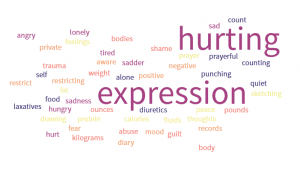
image description: a collage of words identifying emotions.
Creation Space
- Find a list of words that focus on emotions. Print it out or save it to your phone (there are amazing examples online).
During your day, when you struggle to find words to describe how you are feeling, glance at your list!
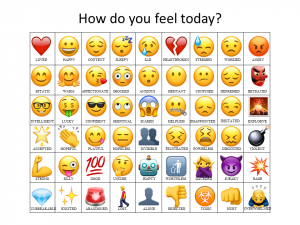
Image description: a chart of emoji to help with identifying emotions
Creation Space: Find a Quiet Place to Create and Reflect
As we start this section of the journal, we encourage you to find a quiet spot to sit and rest as you reflect, create and journal. Take a few minutes to prepare, maybe make a cup of tea in your favourite mug, find a warm blanket in a quiet space, find a pen and a journal or piece of paper. We encourage you to be ready to pay attention to your thoughts and feelings.
Today
- How do you feel today?
Be truthful with yourself. Remember your journal belongs to you, no one else, unless you decide to share your thoughts and feelings. In response to this creation, Janet journaled and sketched the following:
‘In this image I drew a small home reminding me of comfort and I added a small craft shop where I create art. The buildings are dominated by trees – they remind me to look up toward the skies for encouragement and support. I have a deep faith in a higher power. Yet, I am also aware of stress at work. I cannot go all day and be consumed by counting calories. My black pants do not fit right today. I am hiding under four shirts and jackets. I have fruit for lunch. So to gain quietness in my mind I turned on the music on my headset as I write. I tap my feet to the live Ceilidh music. This grounds me. The counting stops, my heart rate goes back to normal. This is one way to answer the question and (be truthful). In the past I would not have been able to link how I feel to words, this is always growing in my heart and soul”.

Why Emotions Matter
Asking ourselves how we feel is not always easy to do. In the book, The Gift of Therapy, Yalom (2017) reminds us that we are complex people who need time to heal. One of the things we have learned in this section is that emotions and feelings are ours to own; they do not belong to anyone else. Identifying words to describe emotions and feelings is a rich part of your journey. Emotions and feelings have varied definitions depending on the authors you read and study. If you look at the writings of Johnmarshall Reeve (2015) who studied emotions, he reminds us that emotions are “short-lived, feeling- purposive- expressive- bodily responses that help us adapt to the opportunities and challenges we face during important life events” (p. 340).
This image is from Reeve (2015), and it explains the complexities of emotions. the author describes feelings as subjective and coming from you. They help us understand our individual experiences at work, play, and home. We have amazing bodies that have the ability to respond to emotions, and with an eating disorder, we may harm our body when really, we should be trying to process emotions (Fox, 2009). Our emotions are also our social expression identified through our faces (eyes, nose, mouth, ears, flushing of our skin) and voices (soft, medium, loud, yelling). Together, these social expressions help us understand our expression in response to life. Emotions also help us describe our motivations. Reeve (2015) states that significant life events have an impact on emotions.

One of the challenges with emotions is that they may affect your choices and therefore your behaviours. For example, from our experiences we share the following: If you are angry, you may hurt yourself by not eating, counting calories, binging, vomiting, or taking diuretics or laxatives. If you are sad, you may count things, and seek to control every aspect of your world. If you are lonely, you may eat, over-eat not pay attention to what you are eating, or the volume of what you are eating. If you are tired, you may just not eat, go to bed and ignore life.
Creation Space
We may ask ourselves, what are the purpose of emotions? Basic emotions are often identified as the following: interest in life and events, joy (includes enjoyment, happiness, and contentment), sadness, anger, disgust, and fear.
- What do you think about each emotion listed above?
- Do you identify with one emotion more than another?
- Do you make links between your eating and emotions?
Linking Emotions to Eating and Food
It takes time to understand the links and relationship of one’s emotions to food, eating and self-care. This takes hard work and the support of trusted clinicians.
Creation Space
It was only with time and attending appointments that trusted clinicians taught me to pay attention to how I was feeling while I was trying to eat, or trying to organize my meals and snacks for the day. One basic acronym I learned was asking myself if I was:
- H (hungry, hurt),
- A (angry, anxious),
- L (lonely, loved), and or
- T (tired, tested).
Using the HALT term, supports one to ask: “Am I hungry, angry, lonely, or tired?” This is an important practice as it reminds us we are complex humans with emotions and feelings and must always be aware of these emotions and feelings. Janet stated “when I practice HALT, I slowed down in time to think more deeply about my emotions and food consumption.
- What do you think of HALT?
- Do you have a proactive acronym (like HALT) that you could create?
- Do you think you pay attention to your emotions?
Positive and Negative Emotions and Everything in Between
Courtney Ackerman (2022) a specialist in Positive Psychology, organizes emotions by positive and negative emotions. Ackerman, emphasizes that both are necessary and purposeful. Ackerman lists emotions this way:
| Some common positive emotions include: | A few of the most commonly felt negative emotions are: |
| Love | Fear |
| Joy | Anger |
| Satisfaction | Disgust |
| Contentment | Sadness |
| Interest | Rage |
| Amusement | Loneliness |
| Happiness | Melancholy |
| Serenity | Annoyance |
| Awe | Grief and loss |
Creation Space
- Using the list above, which positive and negative emotions do you feel right now?
- What words might you link to times when you are around food.
- Which emotion words cause you tension or worry.
Activity: Person Watching and Person Drawing
A social worker taught me this 16-box approach to emotions. The goal was to pay attention to emotional language by watching people and their actions and behaviors. The purpose was to increase my vocabulary and knowledge of words used to describe how I thought and felt. It was a challenge to do this activity. It drew me out of myself and taught me to learn about my emotional vocabulary. Here are the steps and I will show you an example that I completed (Kuhnke, 2022).
Creation Space
Step 1: Divide a plain sheet of paper into 16 boxes
Step 2: During your day, list words that you thinks are associated with others’ emotions (e.g., anger, frustration, happiness).
Step 3: Doodle or sketch the facial expression that matches what you saw in another person.
Step 4: Add colors using crayons, pencil, or charcoal if you like. Ponder and think about the words and images that emerged. Here is an example from my journals (Kuhnke, 2022).
Step 5: If you choose, share your activity with a trusted friend or health care provider. Discuss emotions, thoughts and feelings.
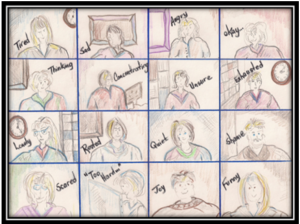
We all think and feel but it is how we channel these emotions that can lead us to unhealthy or healthy behaviour. You a wonderful human being, engaging in self-destructive behaviour that you may not have chosen. You could manage the discomfort with preoccupation with calories, weight, body image, or exercise. When it started to affect your health, you became more preoccupied. It became an unhealthy cycle of obsession and preoccupation.
Managing emotions is difficult especially when your feelings are disruptive or uncomfortable. It is sometimes easier not to focus on the emotion that is disturbing us and put our energy into something we feel we can control.
List of Words and definitions to help Identify Emotions
Here are some definitions of basic emotions:
Fear
- The tendency is to flee and protect oneself. Example: Block out issues and ignore the person, or issue causing the fear
Anger
- The eruption of uncontrolled emotion is related to disappointment. Example: Verbally or physically lash out when confronted with unpleasant news.
Disgust
- Arousing revulsion or strong indignation. Example: Unpleasant to see, smell, taste, consider. This can be your own body.
Contempt
- A feeling as though you are worthless, without consideration, or deserving scorn. Example: Low Self-esteem
Sadness or loss
- Feeling sad or as though you lost a part of yourself or something. Example: Depression
Joy
- States of happiness or feeling of great pleasure.Example: Happy to lose weight.
Interest
- A feeling that accompanies or causes special attention to someone. Example: A hobby you enjoy.
There are times when discussing and writing about emotions causes discomfort. Here is an activity to trial called Timed Art.
Steps to Complete
1. Find a blank piece of cardboard or paper
2. Within 5 minutes create an image of your choice, focusing on emotions
3. Add 4-5 words to describe your work of art.
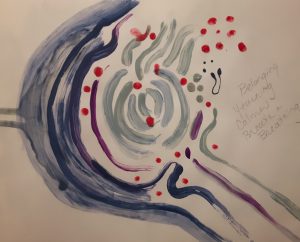
Do memories cause you discomfort?
It is common to have a range of emotions and sometimes, it is difficult to discern how we feel. Processing emotions can also be challenging, especially when they arise without warning. Whereas other emotions are self-conscious emotions. These emotions require self-reflection or self-evaluation. These are social emotions, meaning they usually occur in a social context.
Self-conscious Emotions
- Shame
- Guilt
- Embarrassment
- Pride
- Triumph
Creation Space

When living with and recovering from an eating disorder, you may be asked to pay attention to how you feel as you begin to improve your eating activities.
- What are you feeling while you eat?
- Do you journal before, during or after meals and snacks?
- Insert an image of the art you created here.

